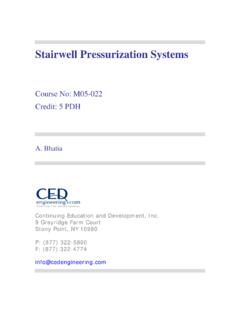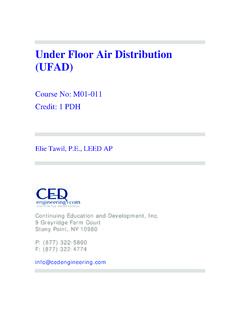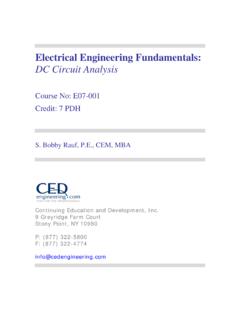Transcription of Process Piping Fundamentals, Codes and Standards
1 Process Piping Fundamentals, Codes and Standards Course No: M05-023 Credit: 5 PDH A. Bhatia Continuing Education and Development, Inc. 9 Greyridge Farm Court Stony Point, NY 10980 P: (877) 322-5800 F: (877) 322-4774 Process Piping Fundamentals, Codes and Standards Module 1 1 Process Piping Fundamentals, Codes and Standards One of the most important components of the Process infrastructure is the vast network of pipelines literally millions and millions of miles. The term Process Piping generally refers to the system of pipes that transport fluids ( fuels, chemicals, industrial gases, etc.) around an industrial facility involved in the manufacture of products or in the generation of power. It also is used to describe utility Piping systems ( , air, steam, water, compressed air, fuels etc.)
2 That are used in, or in support of the industrial Process . Also, certain drainage Piping , where corrosive or toxic fluids are being transported and severe conditions may be present, or where it is simply outside the scope of plumbing Codes , is also sometimes classified as Process Piping . Some places where Process Piping is used are obvious, such as chemical and petrochemical plants, petroleum refineries, pharmaceutical manufacturing facilities, and pulp and paper plants. However, there are many other not so obvious places where Process Piping is commonplace, such as semiconductor facilities, automotive and aircraft plants, water treatment operations, waste treatment facilities and many others. This course provides fundamental knowledge in the design of Process Piping .
3 It covers the guidance on the applicable Codes and materials. This course is the 1st of a 9-module series that cover the entire gamut of Piping engineering. All topics are introduced to readers with no or limited background on the subject. This course is divided in Three (3) chapters: CHAPTER -1: THE BASICS OF Piping SYSTEM This chapter covers the introduction to the pipe sizes, pipe schedules, dimensional tolerances, pressure ratings, frequently used materials, criterial for material selection, associations involved in generating Piping Codes , design factors depending on fluid type, pressure, temperature and corrosion, roles and responsibilities of Piping discipline, key Piping deliverables and cost of Piping system. CHAPTER 2: DEFINITIONS, TERMINOLOGY AND ESSENTIAL VOCABULARY This chapter provides essential definitions and terminology, Process Piping Fundamentals, Codes and Standards Module 1 2 each Piping engineer and designer should familiar with.
4 This is based on the Author s experience on the use of vocabulary in most design engineering, procurement and construction (EPC) companies. CHAPTER 3: DESIGN Codes AND Standards This chapter discusses the associations involved in generating Piping Codes and material specifications. It provides description of various ASME pressure Piping Codes such as Power Piping , Process Piping , Pipeline Transportation Systems for Liquid Hydrocarbons, Refrigeration Piping and Heat Transfer Components, Gas Transmission and Distribution Piping Systems, Building Services Piping and Slurry Transportation Piping Systems. It also provides information on the associations involved in material specifications such as API - American Petroleum Institute Standards , ASTM American Society of Testing Materials, ASME Piping Components Standards , American Welding Society (AWS), American Water Works Association (AWWA) and EN European Standards .
5 Process Piping Fundamentals, Codes and Standards Module 1 3 CHAPTER - 1 1. THE BASICS OF Piping SYSTEM A Piping system is an assembly of pipe, fittings, valves, and specialty components. All Piping systems are engineered to transport a fluid or gas safely and reliably from one piece of equipment to another. Piping is divided into two main categories: Small bore lines Large bore lines As a general practice, those pipe lines with nominal diameters 2 (50mm) and under are classified as small bore and greater than 2 (50mm) NB as large bore. This course is designed to introduce you to the basic concepts of Piping engineering, which is all about designing, fabricating and constructing lines for conveying fluids. ABBREVIATIONS NPS Nominal Pipe Size DN Diam tre Nominal ID Inside Diameter OD Outside Diameter SCH Schedule (Wall Thickness) STD Standard Weight Wall Thickness XS Extra Strong Wall Thickness XXS Double Extra Strong Wall Thickness PIPE SIZES Pipe sizes are designated by two numbers: Diameter and Thickness.
6 In the US, pipe size is designated by two non-dimensional numbers: Nominal Pipe Size (NPS) and schedule (SCH). Let s check some key relationships: Nominal pipe size (NPS) is used to describe a pipe by name only. Nominal pipe size (NPS) is generally associated with the inside diameter (ID) for sizes 1/8 to 12 . For sizes 14 and beyond, the NPS is equal to the outside diameter (OD) in inches. Process Piping Fundamentals, Codes and Standards Module 1 4 Outside diameter (OD) and inside diameter (ID), as their names imply, refer to pipe by their actual outside and inside measurements. Outside diameter (OD) remains same for a given size irrespective of pipe thickness. Schedule refers to the pipe wall thickness. As the schedule number increases, the wall thickness increases, and the inside diameter (ID) is reduced.
7 Nominal Bore (NB) along with schedule (wall thickness) is used in British Standards classification. Important In Process Piping , the method of sizing pipe maintains a uniform outside diameter while varying the inside diameter. This method achieves the desired strength necessary for pipe to perform its intended function while operating under various temperatures and pressures. It is also important to maintain certain interchangeability of pipe fittings. The European designation The European designation equivalent to NPS is DN (Diam tre Nominal/nominal diameter). The pipe sizes are measured in millimetres. Relationship - NPS and DN pipe sizes NPS 3/4 1 1 1 2 2 3 3 4 DN 15 20 25 32 40 50 65 80 90 100 Note - For NPS of 4 and larger, the DN is equal to the NPS multiplied by 25 (not ).
8 PIPE SCHEDULES (SCH) The Schedule of pipe refers to the wall thickness of pipe in the American system. Eleven schedule numbers are available for Carbon Steel Pipes: 5, 10, 20, 30, 40, 60, 80, 100, 120, 140, & 160 The most popular schedule, by far, is 40. Schedules 5, 60, 100, 120, & 140 have rarely been used. Thickness of the pipe increases with the schedule number. This means that: Process Piping Fundamentals, Codes and Standards Module 1 5 Schedule 80 steel pipes will be heavier and stronger than schedule 40 pipe. Schedule 80 pipe will provide greater factor of safety allowing it to handle much higher design pressures. Schedule 80 pipe will use more material and therefore costlier to make and install. Stainless steel Piping schedules generally match with Carbon Steel Piping schedules, but are always identified with Suffix S from 1/8 to 12.
9 Schedule 40S and 80S are the same as their corresponding schedule 40 and 80 in all sizes except 12 in schedule 40. How to calculate Schedule? A simple rule of thumb expression is: Schedule Number = (1,000) (P/S) Where, P = the internal working pressure, psig S = the allowable stress (psi) for the material of construction at the conditions of use. Example Calculate allowable internal pressure P for Schedule 40 mild steel pipe having ultimate tensile strength (S value) of 65,300 psi. Rearrange the schedule equation: P = SCH x S/1,000 Therefore, P = 40 x 65,300/1,000 = 2,612 psi. This is reasonable, based on a current-day published value of 2,849-psi for 1-inch Schedule 40 steel pipe. INTERNAL DIAMETER (ID) OF PIPE For Process engineers, the most important parameter for hydraulic sizing is the pipe Internal Diameter (ID).
10 The ID can then easily be calculated as: ID = OD - 2t Process Piping Fundamentals, Codes and Standards Module 1 6 Example A 4 inches Schedule 40 pipe has an outside diameter of inches, a wall thickness of inches. Therefore, Pipe ID = inches 2 x inches = inches A 4 inches Schedule 80 pipe has an outside diameter of inches, a wall thickness of inches. Therefore, Pipe ID = inches 2 x inches = inches Piping DIMENSIONAL Standards Pipe sizes are documented by a number of Standards , including API 5L, ANSI/ASME in the US, and BS 1600 and BS 1387 in the United Kingdom. Typically, the pipe wall thickness is the controlled variable, and the Inside Diameter ( ) is allowed to vary. The pipe wall thickness has a variance of approximately percent. Standard Carbon Steel Welded and Seamless Pipe Sizes ANSI/ASME Nominal Pipe Size (NPS) Pipe Schedule Outside Diameter Inside Diameter Wall Thickness 40 80 160 1 40 1 80 1 160 40 80 160 40 80 160 2 40 5 2 80 5 2 160 5 40 5 80 5 160 5 Process Piping Fundamentals, Codes and Standards Module 1 7 Nominal Pipe Size (NPS)









